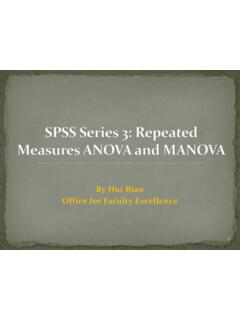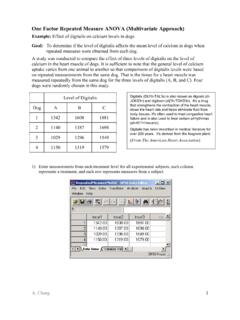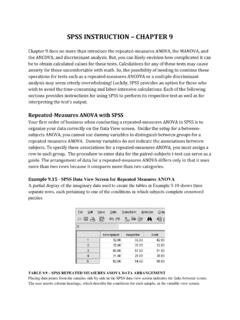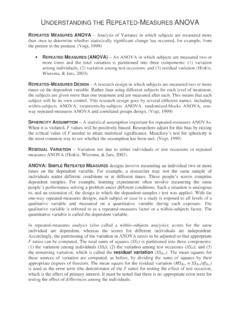Transcription of Longitudinal Data Analysis: Repeated Measures …
1 Longitudinal data Analysis: Repeated Measures ANOVAA aron JonesDuke UniversityBIOSTAT 790 April 7, 2016 Aaron Jones (BIOSTAT 790)RM ANOVAA pril 7, 20161 / 14 Overview1 Multivariate ModelsGEE vs. GLMMMANOVA vs. RM ANOVA2RM ANOVA Model3RM ANOVA Examples: SS & F-Tests4 SphericityAaron Jones (BIOSTAT 790)RM ANOVAA pril 7, 20162 / 14 GEE vs. GLMMF amiliar GLM, ANOVA assume independent residualsCorrelated outcomes require multivariate extensionGeneralized Estimating Equations (GEE)Only need mean model and working correlation matrixNeither assumes nor estimates sources of varianceGeneralized Linear Mixed Model (GLMM)Likelihood-based, need to specify random effectsIn return, estimates variance due to each sourceAaron Jones (BIOSTAT 790)RM ANOVAA pril 7, 20163 / 14 MANOVA vs.
2 RM ANOVAANOVA: Gaussian linear (mixed) model with categorical predictorsHow to extend to multivariate/correlated outcomes?Multivariate ANOVA (MANOVA)Compares residual covariance matrix to model covarianceAllows multivariate outcomes across different scalesNo assumptions about covariance except symmetric, pos. : More degrees of freedom = lower powerRepeated Meaures ANOVA (RM ANOVA)Compares sums of squares including subject-level random effectOnly makes sense for Repeated Measures of same variableRequires stronger assumptions about covariance matrixBenefit: Greater power than MANOVA when assumptions are metAaron Jones (BIOSTAT 790)RM ANOVAA pril 7, 20164 / 14RM ANOVA ModelRM ANOVA (Mixed) Model:yij= ij+ ij+eijyij: continuous response of subjecti= 1.
3 ,nat timej= 1,..,t ij: fixed population mean at timejfor individuals like individualiIncludes covariates and (non-subject-specific) time effects ij: random subject effect for subjectiat timejE(yij| ij) = ij+ ijeij: normally distributed random error for subjectiat timejCrowder and Hand (1990) trichotomy: ij: immutable constant of the universe ij: lasting characteristic of the individual eij: fleeting aberration of the moment Aaron Jones (BIOSTAT 790)RM ANOVAA pril 7, 20165 / 14RM ANOVA ModelFundamental Assumptions:E( ij) = 0,Var( ij) = 2 jE(eij) = 0,Var(eij) = 2ejCov( ij, i j) = Cov( ij, i j ) = 0 Cov( ij, ij ) = jj fori6=i ,j6=j Cov(eij,ei j ) = 0 fori6=i ,j6=j Cov( ij,ei j ) = 0 for alli,i ,j,j Normality: ij N(0, 2 j),eij N(0, 2ej)Common (but Not Necessary) Simplifying Assumptions: 2 j= 2 for allj jj constant for allj,j 2ej= 2efor alljAaron Jones (BIOSTAT 790)RM ANOVAA pril 7, 20166 / 14RM ANOVA ModelCovariance.
4 Cov(yij,yi j ) =E[(yij ij)(yi j i j )]=E[( ij+eij)( i j +ei j )]=E[ ij i j + ijei j +eij i j +eijei j ]=E[ ij i j ] + 0 + 0 +E[eijei j ]= 2 jifi=i ,j=j jj ifi=i ,j6=j 0ifi6=i +{ 2ejifi=i ,j=j 0otherwise= 2 j+ 2ejifi=i ,j=j jj ifi=i ,j6=j 0ifi6=i Aaron Jones (BIOSTAT 790)RM ANOVAA pril 7, 20167 / 14RM ANOVA ModelCorrelation:Observations are uncorrelated between subjectsWithin-subject (intraclass) correlation:Corr(yij,yij ) = jj [( jj+ 2ej)( j j + 2ej )]1/2 Under simplifying assumptions that 2ej= 2eand jj = 2 :Corr(yij,yij ) = = 2 2 + 2eAaron Jones (BIOSTAT 790)RM ANOVAA pril 7, 20168 / 14 One Sample RM ANOVAyij= + i+ j+eijSource SSdfMSE(MS)TimeSSTt 1 MST=SSTt 1 2e+n 2 SubjectsSSSn 1 MSS=SSSn 1 2e+t 2 ResidualSSR(n 1)(t 1)MSR=SSR(n 1)(t 1) 2eSST= ni=1 tj=1( )2=n tj=1( )2 SSS= ni=1 tj=1( yi.)}
5 2=t ni=1( yi. )2 SSR= ni=1 tj=1(yij yi. + )2F=MSTMSR Ft 1,(n 1)(t 1)underH0: j= 0 jand sphericityAaron Jones (BIOSTAT 790)RM ANOVAA pril 7, 20169 / 14 Multiple Sample (Hierarchical) RM ANOVAyij= + h+ j+ ( )hj+ i(h)+ehijSourceSSdfE(MS)GroupSSGs 1 2e+t 2 +DGSubjects(Group)SSS(G)n s 2e+t 2 TimeSSTt 1 2e+DTGroup TimeSSGT(s 1)(t 1) 2e+DGTR esidualSSR(n s)(t 1) 2eDG=nts 1 sh=1 2hDT=nst 1 tj=1 2jDGT=n(s 1)(t 1) sh=1 tj=1( )2hjAaron Jones (BIOSTAT 790)RM ANOVAA pril 7, 201610 / 14 Multiple Sample (Hierarchical) RM ANOVASSG= sh=1 nhi=1 tj=1( )2=t sh=1nh( )2 SSS(G)= sh=1 nhi=1 tj=1( yhi. )2=t sh=1 nhi=1( yhi. )2 SST= sh=1 nhi=1 tj=1( )2=n tj=1( )2 SSGT= sh=1 nhi=1 tj=1( + )2 SSR= sh=1 nhi=1 tj=1(yhij yhi.)
6 + )2F=MSGMSS(G) Fs 1,n sunderH0: h= ( )hj= 0 h,jand within-group covariance matrices equalF=MSTMSR Ft 1,(n s)(t 1)underH0: j= ( )hj= 0 h,jand within-group covariance matrices equal, and sphericityF=MSGTMSR F(s 1)(t 1),(n s)(t 1)underH0: ( )hj= 0 h,jand within-group covariance matrices equal, and sphericityAaron Jones (BIOSTAT 790)RM ANOVAA pril 7, 201611 / 14 SphericityAssumption needed forFstatistic to haveFdistribution with rightdfMultiple ways to express sphericity:1 Var(yij yij ) is constant for allj,j 2 =t2( ii ..)2(t 1)(S 2t 2i.+t2 )= 1, where iiis the mean of the entries on the main diagonal of ..is the mean of all the elements of the mean of the entries in rowiof Sis the sum of the squares of the elements of 3 Keselman, Algina & Kowalchuk:C C= It 1, whereCis a normalized matrix oft 1 orthogonal contrasts amongttimes is a scalarMauchly test of sphericity: sensitive to sample size, non-normalityAaron Jones (BIOSTAT 790)RM ANOVAA pril 7, 201612 / 14 Sphericity vs.
7 Compound SymmetryCompound symmetry = sphericity, but they are not equivalentVar(yij) = Var(yij ) for allj,j + sphericity = compound symmetryThough mathematically possible, hard to imagine Var(yij)6= Var(yij )but covariances all happen to work out to sphericityConclusion: Compound symmetry not theoretically necessary forsphericity and validFtests, but practically it may as well beAaron Jones (BIOSTAT 790)RM ANOVAA pril 7, 201613 / 14 Lack of SphericityHow to proceed when sphericity does not hold?MANOVAS phericity replaced by equal within-group covariance matricesTest whether the means oft 1 differences are equal across groupsFour different test statistics summarize covariance matrix different waysMore degrees of freedom = lower powerAdjust degrees of freedom:F F (t 1), (t 1)(n 1)Greenhouse & Geisser: Plug in MLE estimated from samplecovariance matrixSHuynh & Feldt: Plug in = min(1,n(t 1) (t 1)(n 1 (t 1) ))GG can be too conservative, especially for > andn<2tHF is less biased than GG, performs better when > back to (G)LMMMore flexibility to specify different covariance structuresSo why try RM ANOVA at all?
8 Adjustingdffor validF-test withnear-sphericity may still be more powerful than GLMM with moredfAaron Jones (BIOSTAT 790)RM ANOVAA pril 7, 201614 / 14










